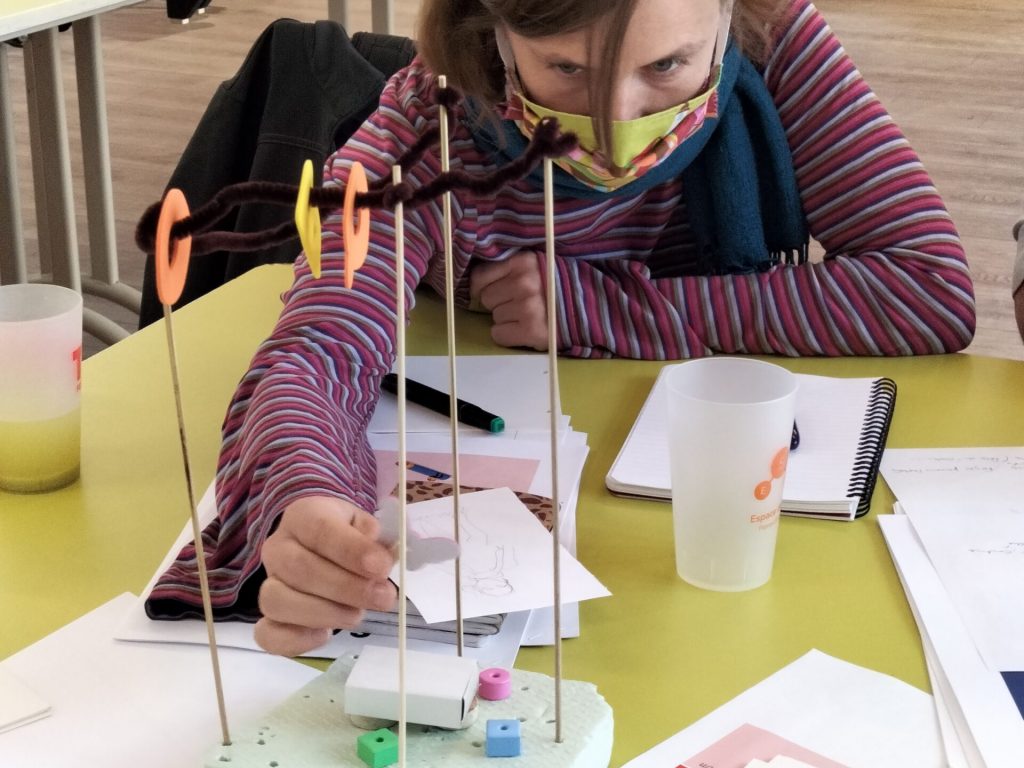Throughout this pilot year, Schools As Living Labs worked with formal and non-formal educators across Europe to understand the needs, fears and difficulties when transforming schools in such a way. Based on that, the project developed a methodology and a series of tools to support them throughout their transformation. To understand why this methodology is so special for teachers and students, we sat down with Claudia Aguirre, project manager at Traces a think-and-do tank based in Paris, France, who led the co-development of the SALL methodology.
Schools As Living Labs. Claudia, could you briefly describe what is the Schools As Living Labs methodology?
Claudia Aguirre. The general idea is to implement a different way of learning, empowering students to become actors of their own educational journey and provide meaning to what they learn at school by integrating learning in real-life communities and settings.
We decided to adapt the living-lab methodology to the school context which is an open-innovation methodology where people participate horizontally in an innovation process to co-create solutions to real problems.
What defines a School As Living Labs project is quite simple: it must address a real issue; all impacted actors must be involved in the process and they must create quick prototypes to put their ideas into practice and evaluate them. That’s all! We made it simple and flexible so that it could be adapted to different cultural environments, schedules, locations or curriculums. Simplicity is the keyword here!
Q. How did you manage to create one methodology that can then be used and owned by very different schools in very different countries?
Claudia Aguirre. I think the strength of the SALL methodology is the way how it was designed, or co-designed I should say. Co-creation is a part of TRACES’ DNA. It’s also 100% embodied in the living-lab philosophy. Not using this approach would simply not have been possible! And it would have been inappropriate to deliver a ‘step-by-step instruction manual’ when the final idea is to develop a collaborative-based learning approach where trust and relationship are central.
We worked really closely with all the partners of this project and with 2 experts in living-lab: Malvina Artheau and Didier Laval, to design an accessible and adaptable methodology, suitable for their various contexts. It was a long process, carried out over many steps: gather resources and literature, create a common culture, collect fears and anxieties, and start making connection with known things. Based on this, we designed a first version of the SALL methodology.
The methodology was then tested in 42 schools across Europe for almost 6 months. During this period, we collected feedback from teachers and developed supporting tools. What was really useful for us was to organise ‘Case Clinic meetings’ where teachers and national coordinators could highlight the obstacles they were facing, things that were missing but also share the creative materials and tools they developed themselves to tackle challenges that we didn’t foresee. And that was highly valuable and gave us meaningful resources to release an enhanced version of the methodology. It’s a 22-page hands-on manual helping science educators to implement open-schooling projects with tested and approved examples and practices.
Q. What does this co-creation approach bring to students and teachers?
Claudia Aguirre. It’s a tough question but, clearly, something built by and with different people benefits from the variety of expertise involved. When biologists study a biological phenomenon, they develop excellent biological solutions. But if you bring a physician, a mathematician and a chemist around the table, they will all start to consider this biological phenomenon from different aspects and it will provide very significant input to the research results. It’s the same here.
Different profiles were involved in this co-creation process: experts in living-lab, researchers, teachers, science educators, museum professionals, explainers, engineers, etc. Their collaboration led to creating a highly-adaptable methodology with a variety of tools that meet different ways of learning. It might be anecdotal, but teachers shared that the SALL methodology was extremely helpful to give room to students who do not feel at home in school, or are extremely shy with adults, or have other ways of experiencing schooling. I also think that it’s highly valuable for students to be engaged with reality sooner in their life. The SALL methodology helps to better understand why we need to learn and how to choose a professional career. Being in contact sooner with different approaches and perspectives on societal issues is a huge plus for students. It helps to attenuate the shock students may have when they first encounter real life outside school.
Want to be involved in open schooling?
More than 50 schools across Europe are already implementing the Schools As Living Labs methodology, transforming their teaching approach to become open-education spaces serving the society. Our next step is to expand this community across 10 countries and 400+ schools: Croatia, Cyprus, Estonia, France, Greece, Israel, Portugal, Serbia, Spain, The Netherlands. If you want to join this open schooling movement, leave us your contact details and our national coordinators will contact you (hello@schoolsaslivinglabs.eu)

